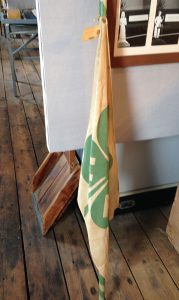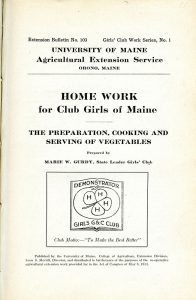The West Rockport 4-H Club 4-H Flag
 The 4-H Flag we have in our exhibit was probably purchased from the National 4-H Supply Service, probably in the late 1930s or early 1940s. Presented to the State 4-H Office by Robert Umberger of West Rockport, ME in 1998; still affixed to the club’s original wooden staff painted like a green and white barbershop pole, green and white being the official colors of 4‑H; Mr. Umberger indicated it had been used for at least 50 years during many 4-H club and 4-H county ceremonial events by the members of the West Rockport 4-H Club.
The 4-H Flag we have in our exhibit was probably purchased from the National 4-H Supply Service, probably in the late 1930s or early 1940s. Presented to the State 4-H Office by Robert Umberger of West Rockport, ME in 1998; still affixed to the club’s original wooden staff painted like a green and white barbershop pole, green and white being the official colors of 4‑H; Mr. Umberger indicated it had been used for at least 50 years during many 4-H club and 4-H county ceremonial events by the members of the West Rockport 4-H Club.
Although obviously an old 4-H Flag, this flag is not the first 4-H Flag to exist, in Maine or elsewhere. In fact, it is uncertain when or why the first 4-H Flag was created. Perhaps it was created to add significance to a 4‑H Camp flag-raising ceremony, giving 4-H a flag to raise in addition to the national flag. Perhaps some 4‑H Member needed a “banner” of sorts to identify his or her club in a parade or community ceremony. Maybe a 4-H club just wanted something to say their 4-H Pledge to! Whatever the reason may have been to place a 4-H Clover in the center of a white, rectangular background and use it as a flag, the concept quickly caught on. Produced in quantity and sold nationally by the National 4-H Supply Service, a 4-H Flag became a standard element of almost every 4-H Club meeting and event across the country right up to the present. In fact, it may be that the National 4-H Supply Service, which organized in 1925, was the first to create a 4-H Flag. A 4-H Flag is among the first items they offered for sale that first year of operation, which is the earliest documentation of a 4-H Flag’s existence the National 4-H History Preservation Team has found.
 Although evidence of its first use on a flag is lacking, the 4-H emblem (a four-leaf clover with an “H” on each leaf) was being used in Maine as early as 1915 to identify the Boys’ and Girls’ Club Work, as it was first called in Maine. Here we see Extension Bulletin #103, Girls’ Club Work Series #1 from 1915 that includes the clover logo and motto. The clover appears on a tomato; the word “Demonstration” above it and the phrase “Girls’ G & C Club” (standing for “Gardening and Canning”) below it. This “tomato emblem” was adopted by Maine after proving popular in southern states as an identity for Extension “Girls’ G & C Club work” programs.
Although evidence of its first use on a flag is lacking, the 4-H emblem (a four-leaf clover with an “H” on each leaf) was being used in Maine as early as 1915 to identify the Boys’ and Girls’ Club Work, as it was first called in Maine. Here we see Extension Bulletin #103, Girls’ Club Work Series #1 from 1915 that includes the clover logo and motto. The clover appears on a tomato; the word “Demonstration” above it and the phrase “Girls’ G & C Club” (standing for “Gardening and Canning”) below it. This “tomato emblem” was adopted by Maine after proving popular in southern states as an identity for Extension “Girls’ G & C Club work” programs.
The name “4-H”, building on the four-leaf clover emblem that was then becoming popular, was first suggested as a national identity for Extension Youth Work by Gertrude Warren of the Federal Extension Service. She was the first to use the name “4‑H” in a national publication in 1918 and argued for its adoption during Extension Service meetings in the early 1920s. She used the name “4-H” in Maine during a visit here in 1924 and Maine began to use “4-H” instead of “Boys’ and Girls’ Club Work”, or at least inter-changeably, from then on until “4-H” eventually superseded the name “Boys’ and Girls’ Club Work” altogether.
